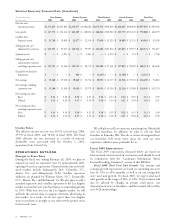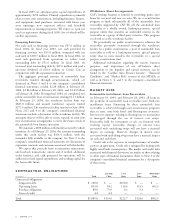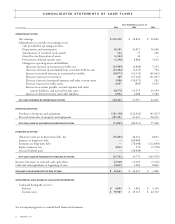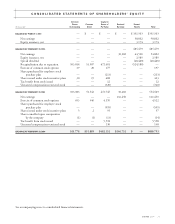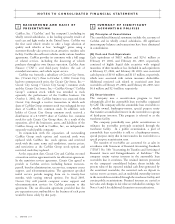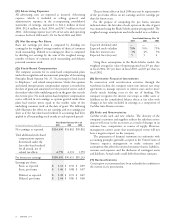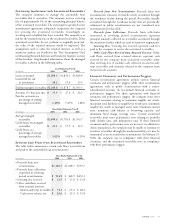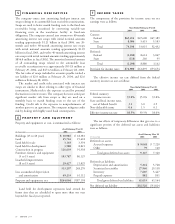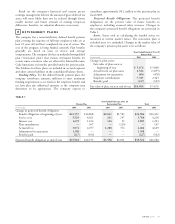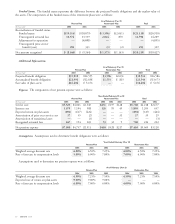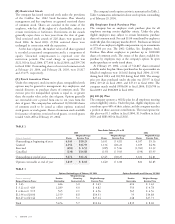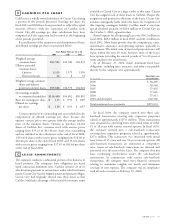CarMax 2004 Annual Report Download - page 36
Download and view the complete annual report
Please find page 36 of the 2004 CarMax annual report below. You can navigate through the pages in the report by either clicking on the pages listed below, or by using the keyword search tool below to find specific information within the annual report.
34
CARMAX
2004
(O) Advertising Expenses
All advertising costs are expensed as incurred. Advertising
expense, which is included in selling, general, and
administrative expenses in the accompanying consolidated
statements of earnings, amounted to $62.4 million in fiscal
2004, $52.4 million in fiscal 2003, and $47.3 million in fiscal
2002. Advertising expense was 1.4% of net sales and operating
revenues for fiscal 2004 and 1.3% for fiscal 2003 and 2002.
(P) Net Earnings Per Share
Basic net earnings per share is computed by dividing net
earnings by the weighted average number of shares of common
stock outstanding. Diluted net earnings per share is computed
by dividing net earnings by the sum of the weighted average
number of shares of common stock outstanding and dilutive
potential common stock.
(Q) Stock-Based Compensation
The company accounts for its stock-based compensation plans
under the recognition and measurement principles of Accounting
Principles Board Opinion No. 25, “Accounting for Stock Issued
to Employees,” and related interpretations. Under this opinion
and related interpretations, compensation expense is recorded on
the date of grant and amortized over the period of service only if
the market value of the underlying stock on the grant date exceeds
the exercise price. No stock option-based employee compensation
cost is reflected in net earnings, as options granted under those
plans had exercise prices equal to the market value of the
underlying common stock on the date of grant. The following
table illustrates the effect on net earnings and net earnings per
share as if the fair-value-based method of accounting had been
applied to all outstanding stock awards in each reported period:
Years Ended February 29 or 28
(In thousands except per share data)
2004 2003 2002
Net earnings, as reported $116,450 $94,802 $90,802
Total additional stock-based
compensation expenses
determined under the
fair-value-based method
for all awards, net of
related tax effects 6,759 4,391 1,559
Pro forma net earnings $109,691 $90,411 $89,243
Earnings per share:
Basic, as reported $1.13$ 0.92 $ 0.89
Basic, pro forma $1.06$ 0.88 $ 0.87
Diluted, as reported $1.10$ 0.91 $ 0.87
Diluted, pro forma $1.04$ 0.86 $ 0.86
The pro forma effect on fiscal 2004 may not be representative
of the pro forma effects on net earnings and net earnings per
share for future years.
For the purpose of computing the pro forma amounts
indicated above, the fair value of each option on the date of grant
was estimated using the Black-Scholes option-pricing model. The
weighted average assumptions used in the model were as follows:
Years Ended February 29 or 28
2004 2003 2002
Expected dividend yield ———
Expected stock volatility 78% 76% 79%
Risk-free interest rates 3% 4% 5%
Expected lives (in years) 554
Using these assumptions in the Black-Scholes model, the
weighted average fair value of options granted was $9 per share
in fiscal 2004, $17 per share in fiscal 2003, and $3 per share in
fiscal 2002.
(R) Derivative Financial Instruments
In connection with securitization activities through the
warehouse facility, the company enters into interest rate swap
agreements to manage exposure to interest rates and to more
closely match funding costs to the use of funding. The
company recognizes the interest rate swaps as either assets or
liabilities on the consolidated balance sheets at fair value with
changes in fair value included in earnings as a component of
CarMax Auto Finance income.
(S) Risks and Uncertainties
CarMax retails used and new vehicles. The diversity of the
company’s customers and suppliers reduces the risk that a severe
impact will occur in the near term as a result of changes in its
customer base, competition, or sources of supply. However,
management cannot assure that unanticipated events will not
have a negative impact on the company.
The preparation of financial statements in conformity with
accounting principles generally accepted in the United States of
America requires management to make estimates and
assumptions that affect the reported amounts of assets, liabilities,
revenues and expenses, and the disclosure of contingent assets
and liabilities. Actual results could differ from those estimates.
(T) Reclassifications
Certain prior year amounts have been reclassified to conform to
the current year’s presentation.


